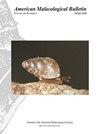圈养和暴露于潜在捕食者线索对北美鹿角系腹足动物壳大小和形状的影响
IF 0.4
4区 生物学
Q4 MARINE & FRESHWATER BIOLOGY
引用次数: 1
摘要
摘要:了解用于界定和诊断物种的特征在多大程度上具有表型可塑性,对于识别物种边界很重要。外壳特征长期以来一直被用来描述腹足类物种,尽管这些特征可能受到环境条件的影响。为了确定北美两种lymnaeid物种的表型可塑性程度,它们出现在不同的栖息地,外壳形态不同,我们在相似的条件下圈养了个体,并比较了野生捕获和圈养种群的外壳形状和大小。我们还将S.elodes个体暴露在潜在捕食者(小龙虾)的排泄物中,以评估捕食者的存在对外壳形态的可能影响。尽管这两个物种在形态上仍然不同,但两个物种的圈养个体的外壳形状与野生捕获个体的明显不同,并且在不同物种之间表现出相似的变化幅度。然而,不同物种之间的变化方向差异很大。尽管暴露于小龙虾线索的埃洛德斯个体的外壳形状与对照蜗牛没有显著差异,但暴露的蜗牛的外壳大小小于未暴露的蜗牛。这些结果表明,暴露在捕食者的环境中会影响葡萄的生长速度。尽管如此,考虑到圈养和捕食者暴露实验中观察到的外壳形状和大小之间的显著关联,外壳形状在发育过程中会发生异速变化。这些结果表明,北美其他Stagnicola物种的形态差异反映了生态表型的变化,但还需要更多的工作来进一步评估这一假设。本文章由计算机程序翻译,如有差异,请以英文原文为准。
Consequences of Captive-Rearing and Exposure to Cues from Potential Predators on Shell Sizes and Shapes of North American Stagnicoline Gastropods (Family Lymnaeidae)
Abstract: Understanding the extent to which traits that are used to delimit and diagnose species are phenotypically plastic is important for recognizing species boundaries. Shell characters have long been used for describing species of gastropods, even though these features may be influenced by environmental conditions. To determine the degree of phenotypic plasticity of two North American lymnaeid species, Stagnicola elodes (Say, 1821) and Stagnicola emarginata (Say, 1821), that occur in different habitats and differ in shell morphology, we reared individuals in captivity under similar conditions and compared shell shapes and sizes of wild-caught and captive-reared populations. We also exposed individuals of S. elodes to effluent from a potential predator (crayfish) to gauge the possible impact of the presence of predators on shell morphology. Although the two species remained morphologically distinct, shell shapes of captive-reared individuals of both species differ significantly from those of wild-caught individuals and show similar magnitudes of change among species. Directions of change, however, differed significantly among species. Although shell shapes of individuals of S. elodes that were exposed to crayfish cues were not significantly different from control snails, shell sizes of exposed snails were smaller than unexposed snails. These results suggest that exposure to predators affects growth rates of S. elodes. Nonetheless, given significant associations between shell shape and size that were observed in the captive-rearing and predator-exposure experiments, shell shape changes allometrically during development. These results suggest that morphological differences of other North American Stagnicola species reflect ecophenotypic variation, but more work is necessary to further evaluate this hypothesis.
求助全文
通过发布文献求助,成功后即可免费获取论文全文。
去求助
来源期刊
CiteScore
1.00
自引率
40.00%
发文量
1
审稿时长
>12 weeks
期刊介绍:
The American Malacological Bulletin serves as an outlet for reporting notable contributions in malacological research. Manuscripts concerning any aspect of original, unpublished research,important short reports, and detailed reviews dealing with molluscs will be considered for publication. Recent issues have included AMS symposia, independent papers, research notes,and book reviews. All published research articles in this journal have undergone rigorous peer review, based on initial editor screening and anonymous reviewing by independent expertreferees. AMS symposium papers have undergone peer review by symposium organizer, symposium participants, and independent referees.

 求助内容:
求助内容: 应助结果提醒方式:
应助结果提醒方式:


